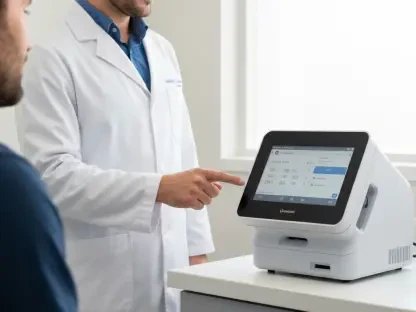The dental soft-tissue regeneration market is on the cusp of a significant transformation. This sector is poised to reach a staggering valuation of $0.53 billion by the decade’s close, with a robust compound annual growth rate of 6.8%. This promising trajectory is largely fueled by a rise in the prevalence of periodontal disease globally, complemented by technological advancements in regenerative materials. Additionally, a surge in dental tourism, coupled with improved reimbursement policies, underscores the evolving landscape of dental care, especially in developing nations. The rise of cosmetic dentistry, driven by its aesthetic appeal, further bolsters market expansion.
Key Drivers Reshaping the Market
Advances in Regenerative Materials
One of the core components propelling the market forward is the continuous enhancement of regenerative materials used in dental procedures. Cutting-edge developments in collagen-based membranes exemplify this trend, offering superior biocompatibility crucial for effective healing and tissue integration. As research and technology progress, these materials are becoming essential tools in modern dentistry, addressing a myriad of dental issues while minimizing the risk of complications. The focus on developing materials that mimic natural tissues has significantly improved procedural outcomes, encouraging broader adoption among dental professionals.
This advancement in regenerative materials is not merely a feat of science but a response to the burgeoning demand for minimally invasive procedures. In an age where patients are more informed and have higher expectations for their dental care, innovations that provide effective solutions with minimal discomfort and downtime are highly prized. This shift has paved the way for enhanced treatment methodologies that prioritize patient comfort and procedural efficiency. In turn, this has opened new avenues for growth, positioning the dental soft-tissue regeneration market as a dynamic field replete with opportunities for innovation and expansion.
The Influence of Dental Tourism
Dental tourism is another influential factor contributing to the market’s burgeoning growth. As individuals seek high-quality dental services at competitive prices, many are traveling overseas to destinations known for excellence in dental care. This trend has fostered the establishment of top-tier dental clinics and service providers in locations renowned for medical tourism, leveraging advanced technologies and offering comprehensive dental packages. These practices not only attract international clients but also stimulate local economies and boost investments in dental infrastructure and education.
The synergistic impact of dental tourism on the soft-tissue regeneration market cannot be overstated. As patients increasingly opt for treatments abroad, the demand for regenerative procedures is on the rise, igniting interest and investment in state-of-the-art technologies that cater to discerning clientele. Countries at the forefront of dental tourism often provide an ecosystem conducive to cutting-edge research, enabling a symbiotic relationship between innovation and patient care excellence. Consequently, the market is witnessing a blend of high-quality service delivery and the integration of advanced dental solutions, which are critical in positioning countries as leaders in cosmetic and restorative dental care.
Market Challenges and Opportunities
Economic and Logistical Challenges
While the market’s growth prospects appear promising, certain hurdles remain that could stymie its expansion. The high cost of treatment, for example, poses a significant barrier for many potential patients, particularly in underdeveloped regions where economic constraints severely limit access to advanced dental care. Another challenge is the unequal distribution of healthcare resources, which creates disparities that are difficult to bridge without significant policy reforms and investments in healthcare infrastructure.
Addressing these hurdles necessitates a multifaceted strategy, involving collaboration between industry leaders, policymakers, and healthcare providers. Incentives for local production of materials and technologies, along with international partnerships, could help mitigate costs while enhancing accessibility. Furthermore, public and private sector investments in healthcare infrastructure are essential for alleviating logistical challenges, facilitating broader reach, and ensuring that emerging technologies benefit a more comprehensive cross-section of the population.
Role of Dental Service Organizations
Dental Service Organizations (DSOs) and independent clinics are pivotal in navigating both the challenges and opportunities within the market. These entities leverage their extensive networks and resources to streamline operations, optimize patient care, and integrate new technologies effectively. As keystones of the dental industry, DSOs play an essential role in standardizing care, training practitioners, and extending the reach of advanced dental services, thereby contributing significantly to market growth.
The involvement of DSOs facilitates consistency in the delivery of high-quality dental care, ensuring patients receive standardized, evidence-based treatments across various locations. Their influence extends to enabling cutting-edge research and development by providing platforms for trials and collaborations with tech firms and academic institutions. As pivotal market players, DSOs exemplify the integration of industry expertise and innovative solutions, vital in overcoming obstacles and continuing the market’s growth trajectory.
Future Prospects and Strategic Directions
The dental soft-tissue regeneration market is on the verge of a transformative phase, projected to achieve a remarkable valuation of $0.53 billion by the end of this decade. This growth is driven by an impressive compound annual growth rate of 6.8%. The primary factors contributing to this promising future are the increasing global prevalence of periodontal diseases and advancements in regenerative technologies. These innovations enhance the efficiency and outcomes of treatments. Furthermore, the rise in dental tourism, particularly in developing countries, is reshaping the landscape of dental care. Improved reimbursement policies make advanced dental procedures more accessible to a broader audience, thus fueling market growth. The rapid expansion of cosmetic dentistry adds another layer of growth, as more people seek aesthetic improvements, such as veneers and implants. Together, these elements create a dynamic market poised for sustained growth, offering exciting prospects for stakeholders in the dental healthcare industry.









